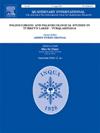Marked regionalism during the Last Glacial across the Italian Peninsula: Evidence from the large mammal assemblage of Santa Maria di Agnano (Apulia, southern Italy)
IF 1.8
3区 地球科学
Q3 GEOGRAPHY, PHYSICAL
引用次数: 0
Abstract
In this study, we present the mammal sample collected from Stratigraphic Unit 8 of the external excavation area of Grotta di Santa Maria di Agnano (Apulia, southern Italy). The material was collected during the 2011, 2015, and 2016 excavation seasons and it is described here for the first time. In this level, lithic tools consistent with the Gravettian techno-complex have been identified. Grotta di Santa Maria di Agnano is renowned for the Upper Palaeolithic burials, Ostuni 1 and Ostuni 2, found inside the cave and dated between 29,495–28,766 years cal BP and 27,809–27375 years cal BP. Thousands of lithic tools, shells, and vertebrate remains have also been found during more than twenty years of excavations. These data provide valuable information about the terrestrial ecosystems of Mediterranean Europe at the end of the Pleistocene and human-animal interactions in the course of the period of dramatic climatic changes that occurred over the last 40,000 years. Finally, we compare this assemblage with other faunal assemblages recovered in Gravettian contexts across the Italian Peninsula, offering an overview of marked regional differences in climatic and environmental conditions reflected in the diversity of mammalian palaeocommunities.
意大利半岛末次冰川时期明显的区域性:来自 Santa Maria di Agnano(意大利南部阿普利亚)大型哺乳动物群的证据
在这项研究中,我们介绍了在意大利南部阿普利亚的格罗塔·迪·圣玛丽亚·迪·阿格纳诺(Grotta di Santa Maria di Agnano)外部挖掘区地层单元8采集的哺乳动物样本。这些材料是在2011年、2015年和2016年的挖掘季节收集的,在这里首次进行描述。在这一层,发现了与格拉维特技术复合体一致的岩屑工具。格罗塔圣玛丽亚迪阿格纳诺以旧石器时代晚期的墓葬而闻名,在洞穴中发现的Ostuni 1和Ostuni 2的年代在公元前29,495-28,766年和公元前27,809-27375年之间。在二十多年的挖掘中,还发现了数千件石器工具、贝壳和脊椎动物遗骸。这些数据提供了关于更新世末期地中海欧洲陆地生态系统的宝贵信息,以及在过去4万年中发生的剧烈气候变化期间人类与动物之间的相互作用。最后,我们将这一组合与意大利半岛格拉维特背景下发现的其他动物组合进行了比较,概述了哺乳动物古群落多样性所反映的气候和环境条件的显著区域差异。
本文章由计算机程序翻译,如有差异,请以英文原文为准。
求助全文
约1分钟内获得全文
求助全文
来源期刊

Quaternary International
地学-地球科学综合
CiteScore
5.60
自引率
4.50%
发文量
336
审稿时长
3 months
期刊介绍:
Quaternary International is the official journal of the International Union for Quaternary Research. The objectives are to publish a high quality scientific journal under the auspices of the premier Quaternary association that reflects the interdisciplinary nature of INQUA and records recent advances in Quaternary science that appeal to a wide audience.
This series will encompass all the full spectrum of the physical and natural sciences that are commonly employed in solving Quaternary problems. The policy is to publish peer refereed collected research papers from symposia, workshops and meetings sponsored by INQUA. In addition, other organizations may request publication of their collected works pertaining to the Quaternary.
 求助内容:
求助内容: 应助结果提醒方式:
应助结果提醒方式:


